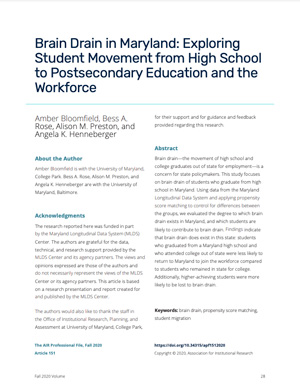The AIR Professional File
Fall 2020, Article 151
Brain Drain in Maryland: Exploring Student Movement from High School to Postsecondary Education and the Workforce
https://doi.org/10.34315/apf1512020Abstract
Brain drain—the movement of high school and college graduates out of state for employment—is a concern for state policymakers. This study focuses on brain drain of students who graduate from high school in Maryland. Using data from the Maryland Longitudinal Data System and applying propensity score matching to control for differences between the groups, we evaluated the degree to which brain drain exists in Maryland, and which students are likely to contribute to brain drain. Findings indicate that brain drain does exist in this state: students who graduated from a Maryland high school and who attended college out of state were less likely to return to Maryland to join the workforce compared to students who remained in state for college. Additionally, higher-achieving students were more likely to be lost to brain drain.
Keywords: brain drain, propensity score matching, student migration
Authors
- Amber Bloomfield, University of Maryland, College Park
- Bess A. Rose, University of Maryland, Baltimore
- Alison M. Preston, University of Maryland, Baltimore
- Angela K. Henneberger, University of Maryland, Baltimore
Copyright © Association for Institutional Research 2020

